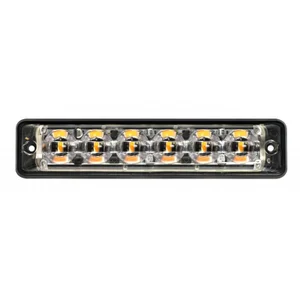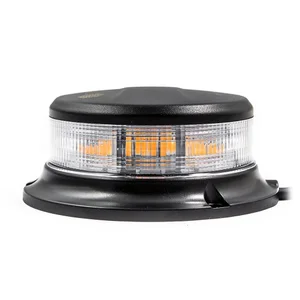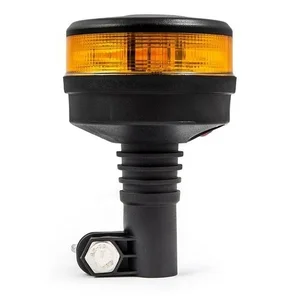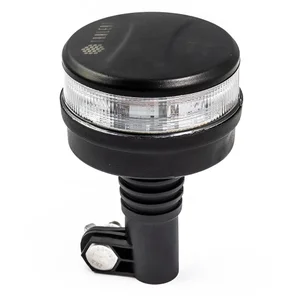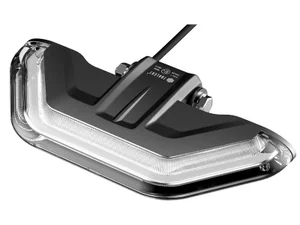In this blog, we explain what is and isn't permitted when it comes to using safety signalling. This signal lighting mainly includes beacons and LED flashers. However, work lights with a flash function, LED bars, and driving lights can also have a flashing function.
European Regulations for Safety Signalling
In Europe, vehicles must comply with the ECE R65 standard for optical safety signalling. The abbreviation 'ECE' stands for 'Economic Commission for Europe'. 'R65' is the specific regulation number. This international regulation precisely defines the flash patterns (60–240 cycles per minute), required light intensity (at least 75 candela per flash), and the color (amber), along with durability requirements such as resistance to vibration and moisture (IP65/IP67).
You can read more about the official standard in our article about the ECE R65 regulation.
ECE R65 Class 1 and Class 2
There are two different classes for safety signalling within the ECE R65 standard. The difference lies in light intensity and application. Class 1 lights have a lower intensity, making them ideal for nighttime operations or low-light situations, such as recovery vehicles operating on highways at night or snow ploughs working in dark conditions. Class 2 lights are more powerful, with a broader light distribution and an automatic night mode, making them suitable for both day and night use—for example, on gritting trucks or special transport vehicles operating in heavy daytime traffic. Class 2 lights with a dimming function also meet Class 1 requirements, making them more versatile.
Note: a ECE R65 class 2 light automatically also meets the requirements of ECE R65 class 1, provided it can dim or be switched accordingly.
Selection Guide: Which Class Suits Your Vehicle
| Vehicle Type | Usage Situation | Recommended Class |
|---|---|---|
| Landbouwvoertuig | Werk op veld/landweg, lage snelheid | Class 1 |
| Mobiele kraan / bouwmachine (bouwterrein) | Alleen binnen bouwterrein | Class 1 |
| Industrieel intern transport | Afgesloten terrein, lage snelheid, geen verkeer buitenaf | Class 1 |
| Takelwagen / bergingsvoertuig | Openbare weg, snelweg, overdag | Class 2 |
| Mobiele kraan / bouwmachine (openbare weg) | Langzaam verkeer op openbare weg | Class 2 |
| Geleidevoertuig / verkeersbegeleider | Begeleiding exceptioneel transport | Class 2 |
| Afvalophaalvoertuig | Gemeentelijke routes, in woonwijken | Class 2 |
| Gladheidbestrijder / sneeuwschuiver | Slechte weersomstandigheden, vaak ’s nachts | Class 2 |
| Ambulance / brandweer / politie | Spoedritten dag en nacht | Class 2 |
| Vrachtwagen met brede lading | Verhoogd gevaar, vaak overdag | Class 2 |
| Landingsbaanvoertuig (luchthaven) | Beweging op luchthavens, zichtbaarheid cruciaal | Class 2 |
| ADR-tankwagen (gevaarlijke stoffen) | Openbare weg, continu transport van gevaarlijke lading | Class 2 |

To obtain an ECE R65 certificate, a light must be tested by an independent testing organization. The testing organization must demonstrate that the lighting meets the requirements of the directive. These requirements concern, among other things, the visibility, performance, and safety of the signal lighting.
An ECE R65 certificate is valid for a period of five years. After five years, the light must be retested to determine whether it still meets the directive's requirements.
Requirements applicable to ECE R65:
- Visibility: The signal lighting must be visible from all directions, including from a distance.
- Performance: The lighting must meet certain performance requirements, such as a minimum brightness and a minimum flash frequency.
- Safety: The lamp must not pose any danger to other road users.
When is signal lighting allowed to be used?
The European directive is in force in the Netherlands and stipulates the following:
''A rotating light/flash lamp may only be used on public roads if it complies with the ECE R65 directive.''
Implementation of ECE R65 directive in the Netherlands
The obligation to comply is laid down in national (Dutch) legislation and regulations. This falls under the 2009 Regulation on Optical and Acoustic Signals.
In the Netherlands, the RDW (National Road Traffic Service) is the authority responsible for the implementation of the ECE R65 directive. They thus determine whether a vehicle meets the conditions to be allowed on Dutch roads. Typically, this is at:
- Rescue, repair, recovery or towing of vehicles;
- Escorting transports for which an exemption has been granted;
- Escorting military columns;
- Agricultural, forestry, or off-road work vehicles that travel at a reduced speed, or trailers pulled by these vehicles that are wider than 2.60 m including the load;
- The transport of an indivisible load for which an exemption has been granted;
- Work around, on or on roads, including snow removal and gritting of slippery roads;
- Providing assistance on or near the road.
360-degree visibility
360-degree visibility with beacons means that the light is clearly visible from all angles to other road users, according to the Regulation on Optical and Sound Signals 2009. This enhances traffic safety by ensuring that the vehicle is well noticed in all situations.
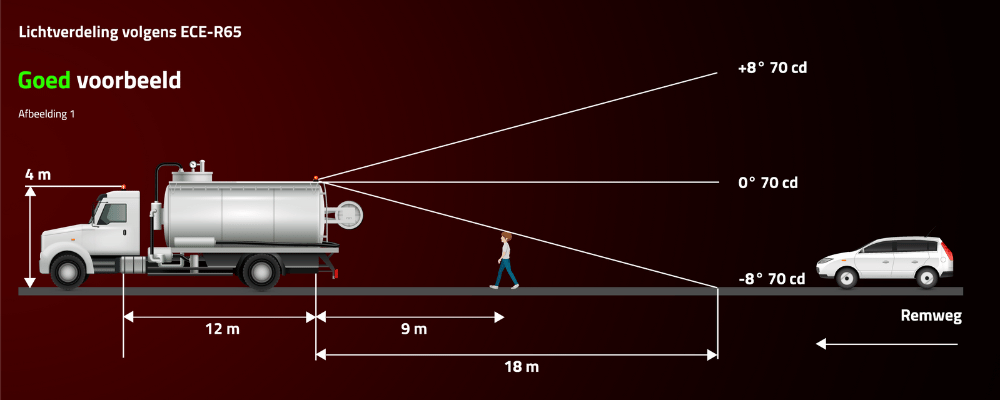
A rotating light/flashing light must be mounted on the vehicle in such a way that the warning signal is recognizable from every position at a distance of 25 meters. If this is not possible, additional warning systems (e.g., extra rotating lights/flashing lights) must be installed on the vehicle.
Good example: In the image above, it is shown that when a rotating light/flashing light is mounted 4 meters high on a vehicle, a person 1.80 meters tall can see the light beams from the lamp (at an angle of -8 degrees) from a distance of 15.7 meters from the vehicle.
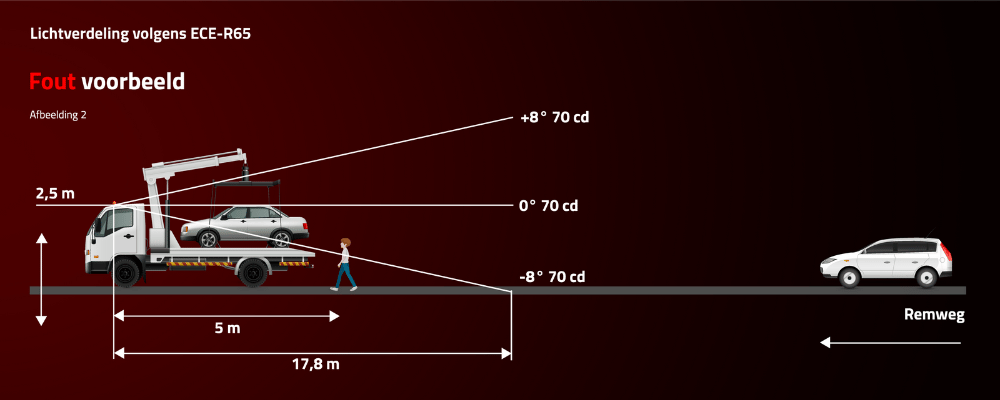
Incorrect example: In the image above, it is shown that the warning light is not recognizable from every direction. In the area of the crane, the warning effectiveness is interrupted. In this case, an additional warning light must be installed either at the rear of the vehicle or on the vehicle's cab.
According to the 'Regulation of Optical and Acoustic Signals 2009', '360-degree visibility' is required. This means that at least one of the signaling lights must be visible within a perimeter of 20 meters and from a viewing height of 1.5 meters.
If during operational activities parts of the vehicle such as cargo, loading cranes, wind deflectors, or the tailgate obstruct the view of the flash lamps, it is necessary to install additional flash lamps or supplementary flashers.
The installation of the lighting set must also be carried out in such a way that the light signal is observable from a perimeter of 20 meters around the entire vehicle, and from a height of 1.5 meters above the road surface.
What if you do not use ECE R65 signal lighting?
The use of non-certified signal lighting can entail various risks and dangers, both in terms of safety and legal liability. If an accident occurs, inspections may be carried out on this.
Using orange beacons on public roads
Are you planning to use an orange beacon on your vehicle? Then you have already learned that it must be equipped with ECE R65 if you want to use it on public roads.
You can use orange beacons in the following situations.
- In work involving the towing away of other vehicles.
- Accompanying transport for which exemption has been granted.
- For the guidance of military convoys
- When driving vehicles with limited speed, think of agricultural vehicles.
- Customs work.
In our blog, are you allowed to have orange flashing lights, you can read all the ins and outs.
Using blue beacons on public roads
This is only allowed in the Netherlands for:
- Road inspectors (from the Department of Public Works);
- Road inspectors (from the Department of Public Works);
- Organ transplantation transport;
- Explosive Ordnance Disposal Services;
- Fire brigade, both fire trucks and support vehicles;
- Undercover police cars;
- Police cars & riot vans;
- Enforcement;
In our blog, may you have blue beacons, you can read all the ins and outs.
Overview of all beacon colors;
Use blue beacon;
Police, ambulance, and fire brigade may only use blue beacons for urgent tasks.
Use green beacon;
Only the command vehicle belonging to the police, fire brigade, or ambulance may use green beacons.
Use yellow beacon;
Emergency services may only use yellow beacons to alert other road users to a special or dangerous situation. For example, when towing a broken-down vehicle. Emergency services using yellow beacons do not have special priority rights.
Read more about it on the page of the UK government
If you want customized advice from our specialists, feel free to contact us!
The TRALERT® team consists of various specialists who are ready to assist you, whether you have specific questions about the purchase of LED beacons or their installation.
Disclaimer: This information is general and informational; it is not intended as legal advice. TRALERT® is not liable and only provides specific advice regarding the ECE regulations.

